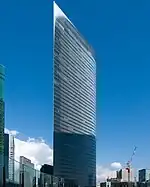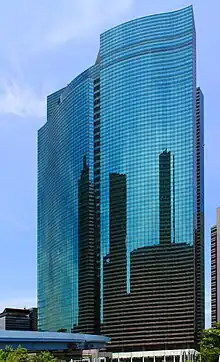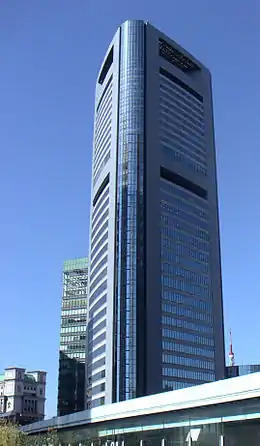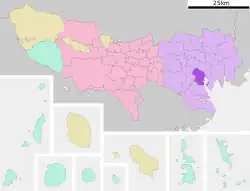Shiodome
Shiodome (汐留) is an area in Minato, Tokyo, Japan, located adjacent to Shinbashi and Ginza, near Tokyo Bay and the Hamarikyu Gardens. Formerly a railway terminal, Shiodome has been transformed into one of Tokyo's most modern areas. It is a collection of 11 tiny town districts or cooperative zones, but generally there are three main areas:
- The Shiodome Sio-Site (シオサイト),[1] a collection of skyscrapers containing mostly businesses, hotels, and restaurants. Its thirteen skyscrapers house the headquarters of All Nippon Airways,[2] Dentsu,[3] Fujitsu,[4] JSR, Mitsui Chemicals,[5] Nippon Express,[6] Nippon TV,[7] Sega Sammy Holdings[8] and Softbank.[9]
- The western district, located west of the JR tracks and populated by European-style buildings.
- The southern extension, east of the JR tracks from Hamamatsucho 1-chome. This area is for residential use, and there are three tall apartment buildings located there, along with a small park.

Shiodome Station is a stop on the Yurikamome and Toei Ōedo Line; the complex is also within walking distance of Shimbashi Station. The Shiodome could be likened with places like Canary Wharf of London.
History
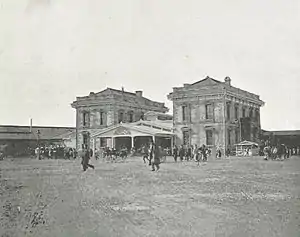
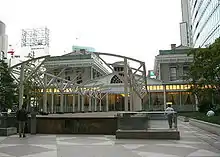
Like its neighbors Ginza and Tsukiji, Shiodome is built on what was originally marshland on the shore of Tokyo Bay. Shōgun Tokugawa Ieyasu issued an order in 1603 to fill in the area, and throughout the Edo period Shiodome housed the local residences of various daimyō (feudal lords).[10] The name Shiodome, which translates to "keeping out the tide", probably referred to the shōgun's desire to isolate Edo Castle (now the Imperial Palace) from Tokyo Bay. There was a Shiodome River but it has been largely filled in.[11] A small portion of the river remains on the west side of Hamarikyu Gardens. A water bus used to service the river.[12]
Following the Meiji Restoration, the new Imperial government expropriated the daimyo-held lands in Shiodome to build Shimbashi Station (新橋停車場, Shinbashi Teishajō). This served as the Tokyo terminus of the Tōkaidō Main Line, the first railway in Japan, from 1872 until 1914. In 1914, the line was extended to Tokyo Station, the passenger terminal at Shiodome was closed down, and Karasumori Station on the Yamanote Line was renamed Shimbashi Station.[10]
Shiodome Freight Terminal remained the primary freight yard for Tokyo through World War II, despite extensive damage from the Great Kanto earthquake which destroyed the original passenger terminal. The 1936 opening of the Tokyo Metropolitan Central Wholesale Market in nearby Tsukiji increased the terminal's importance in the Tokyo distribution network.[10]
The development of expressways in Japan after the war lessened the importance of rail freight. Shiodome Station was officially closed in October 1987, shortly following the privatization of Japan National Railways. The abandoned 22 hectare (54.36 acre) facility, one of the largest open plots of land in central Tokyo, was transferred to the JNR Settlement Corporation in 1988 and earmarked for sale in order to discharge remaining JNR liabilities.[10]
The Japanese government and Tokyo Metropolitan Government held various review sessions between 1984 and 1995 before settling on a redevelopment plan. Under this plan, thirteen skyscrapers were built in Shiodome, as well as a number of smaller buildings, resulting in a new urban center. The old Shimbashi Station has also been rebuilt as a monument, although it is not operational.[10]
Buildings
Major high-rise developments in Shiodome include:
- Acty Shiodome (190.25 m): Japan's tallest condominium tower, developed by the Urban Renaissance Agency.
- Dentsu Building (213.34 m)
- Nittele Tower (198.2 m)
- Shiodome City Center (215.75 m): Corporate headquarters of All Nippon Airways[2] and Fujitsu[4]
- Shiodome Sumitomo Building (126.41 m): Corporate headquarters of JSR and Sega Sammy Holdings, contains the Hotel Villa Fontaine Shiodome.
- Tokyo Shiodome Building (173.2 m): Corporate headquarters of Softbank and several major subsidiaries; upper floors house the Conrad Tokyo hotel.
Parks
References
- "Home". sio-site.or.jp.
- "Principal Offices." All Nippon Airways. Retrieved on December 22, 2008.
- Dentsu Archived 2009-03-28 at the Wayback Machine
- "Fujitsu's Corporate Headquarters Archived 2006-04-27 at the Wayback Machine." Fujitsu. Retrieved on February 4, 2009.
- "Head Office - Branches." Mitsui Chemicals. Retrieved on February 18, 2010.
- nipponexpress
- "Corporate Data|ABOUT Nippon TV|Nippon TV". Archived from the original on 2015-07-11. Retrieved 2015-07-27.
- "." Sega Sammy Holdings. Retrieved on February 2413, 2015.
- "Corporate Headquarters Archived 2008-12-18 at the Wayback Machine." Softbank. Retrieved on December 24, 2008.
- Nishikawa, Yuro (July 2003). "Redevelopment of Shiodome" (PDF). Japan Railway & Transport Review. 35: 48–55. Retrieved April 6, 2010.
- "Japan This! - Why is Shinbashi called Shinbashi?". 26 March 2013. Retrieved September 23, 2015.
- "Canals of the Ginza: floating through time on Tokyo's central waterways". The Tokyo Files. 5 May 2018.
External links
 Tokyo/Shiodome travel guide from Wikivoyage
Tokyo/Shiodome travel guide from Wikivoyage

